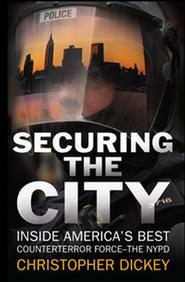
Although the annual homicide rate in NYC dropped from 2,245 to 333 between 1991 and 2013, civilians are now less trusting of law enforcement than they ever have been. Perhaps this is unsurprising in light of the infamous NSA leak by informant Edward Snowden that revealed that the government is not only watching suspected terrorists, but is instead monitoring the nation. No era before has faced such a looming reality of Big Brother as we do in the modern day. Renown author Christopher Dickey, who currently serves as the Paris Bureau chief and Middle East regional editor for tThe Daily Beast, presented a lecture on March 6 on “Policing, Politics and Paranoia in Post 9/11 America.”
Dickey began his presentation by showing a Newsweek video clip of an undercover police helicopter circling NYC. The video was narrated by Dickey himself, as he was observing the procedures and protocols of the NYPD in 2008. The video stirred mixed feelings of pride and confidence in our police force with a true concern of their power and omnipresence. At the conclusion of the clip, Dickey voiced the sobering question on everyone’s mind: the police protect the people from terrorists, but who protects the people from the police?
To understand the context of the post 9/11 surveillance practices and policies, Dickey went back to 1994. This was beginning of former mayor Rudy Giuliani and NYPD Commissioner William Bratton’s term. Under Bratton, Jack Maple was appointed commissioner of crime control strategies, implementing many procedures now considered standard. Among these tactics were the use of CompStat for “policing by numbers,” which uses statistical analysis to determine high risk areas, in addition to what is commonly known as “cops on dots,” the practice of increasing the number of officers in high crime neighborhoods. Bratton was credited with the success of the department, subsequently getting fired by Giuliani in 1996.
Bratton was succeeded by Bernard Kerik who expanded the undercover units and implemented the Stop and Frisk procedure. By early 2000, the fear, which plagued the NYC public for more than a quarter of a century, was abated and the murder rate was at an all time low, under 700. The success of the NYPD heralded praise not only from citizens of the five boroughs but also from the nation who looked toward NYC as the model of effective crime fighting.
Then, tragedy struck on 9/11. Giuliani would spend the end of his term working with emergency response teams and cleanup crews in an attempt to restore a sense of normalcy and security among the people. In 2002, Ray Kelly, the longest serving commissioner of the New York City Police Department, took office with the new priority of preventing crime, not punishing it. Kelly reorganized the NYPD and created a Counter-Terrorism Bureau, implementing Eyes in the Sky, expanding the undercover unit, and running extensive drills in the NYC subway.
Kelly was the first commissioner to exploit the department’s own diversity, realizing that with over 35,000 officers, who have roots in more than 60 countries and possess fluency in a comparable number of languages, their greatest resource lay within the Academy. In response, Kelly appointed former CIA director David Cohen as deputy commissioner of intelligence, and charged him with creating a new NYPD Unit focused solely on prevention. The new Intel Unit actively avoided making arrests, preferring extensive undercover work, surveillance and recruitment of informants. This tactic, which became known as “penetration and disruption,” returned positive results but contained “insidious” practices that seem to get grayer and grayer in respect to civil liberties.
Federal agencies turned to Cohen for leads and information. The NYPD was seeing an upward trend over the past two decades, but in 2011 their reputation was muddied when the Associated Press exposed the unorthodox practices of the Intel Unit, subsequently winning the Pulitzer Prize.
The NYPD put major resources into the Real Time Crime Center, compiling information from public records, crime records and even bill histories, a practice Dickey calls a “pervasive surveillance of metadata.” This center analyzes data streaming in from thousands of private and public cameras throughout the city, using algorithms to watch for suspicious traffic patterns, unattended briefcases, concealed weapons and much more.
To many, the NYPD has taken the lead on strategies and tactics that are more suited for federal than for local authorities. However, this is unsurprising considering the overwhelming size of the department, more than three times as large as the LAPD, which has 10,000 officers. In light of this, it is clear that other cities cannot replicate what the NYPD does, forcing them to rely on the Joint Terrorism Task Force of the FBI. Dickey pointed out that if Snowden’s leak revealed anything, it’s that the world of surveillance has shifted dramatically.
With the advent of fiber optic cables, huge quantities of information are now streamed together on one line. Unlike the former practice of wire tapping, which requires selecting certain communications to monitor, the NSA now intercepts all communications and filters out those it doesn’t want. To compound this, thanks to the genesis of social media where we willingly share information, there appears to be less the government doesn’t know. In addition, the constant development of new technologies, such as the recent breakthroughs made with Drones, surveillance is increasing at an unprecedented rate.
At the end of his talk, Dickey reiterated the question that still hung over the audience: who’s watching the watchers? The answer is that we don’t know. Perhaps if we move past national accusation in favor of a national discussion, the answer may one day become “Big Brother who?”
Dickey's lecture was so-sponsored by the Office of the Dean of Faculty, Office of the President and the Levitt Security Program.
Posted March 7, 2014
